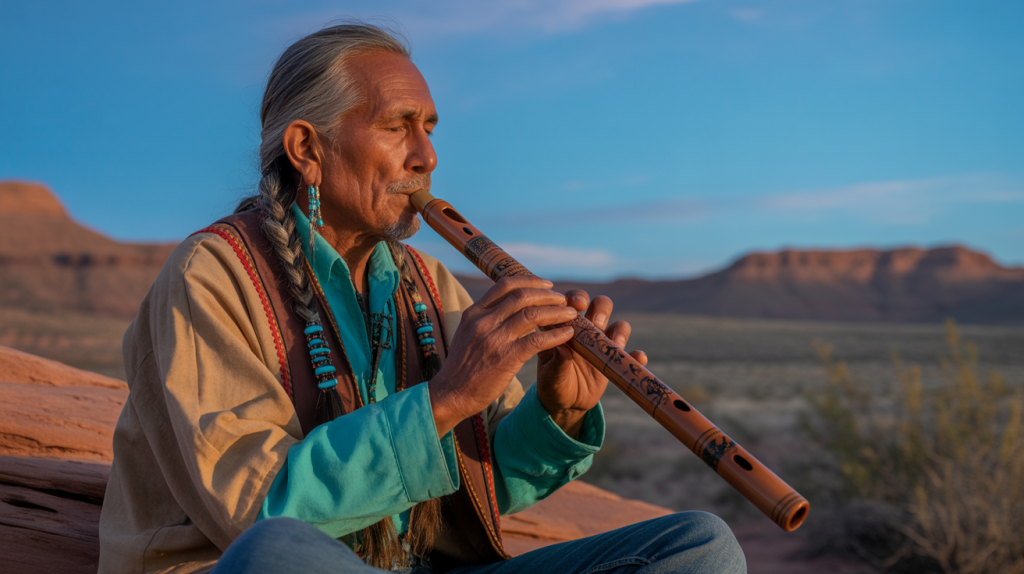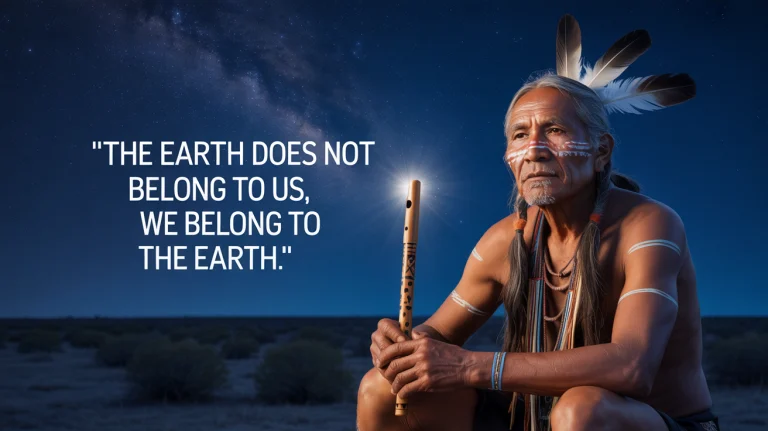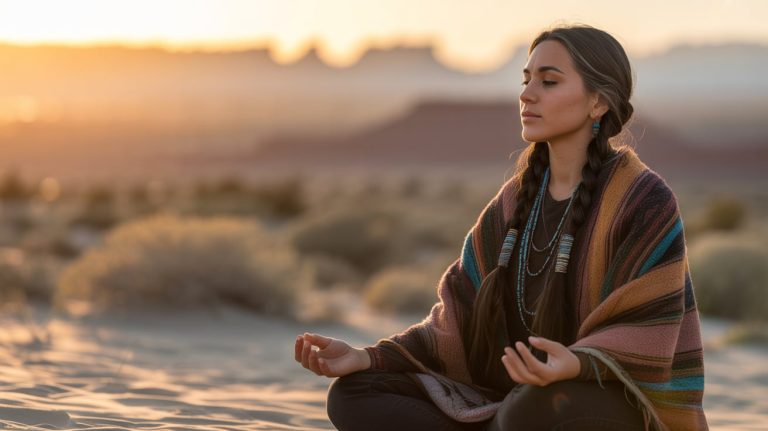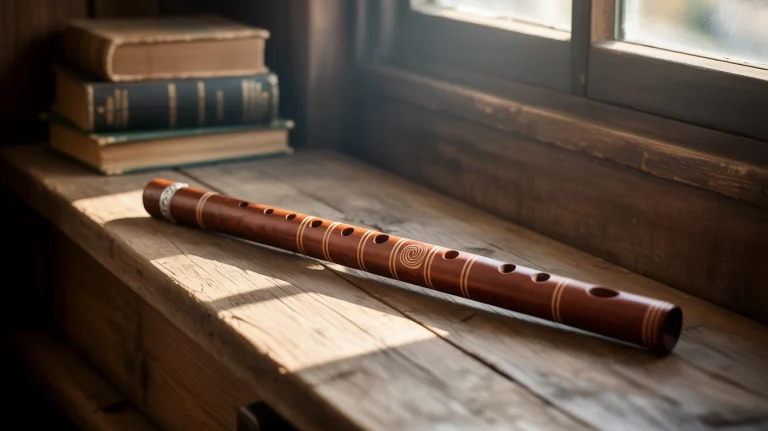Native American music represents one of the world’s oldest and most spiritually significant musical traditions, spanning thousands of years and hundreds of distinct tribal cultures across North America.
From the haunting melodies of the Native American flute to the powerful rhythms of powwow drumming, Indigenous music continues to serve as a vital bridge between ancestral wisdom and contemporary expression.
This comprehensive guide explores the rich tapestry of Native American musical traditions, instruments, regional styles, and modern evolution while honoring the cultural significance and sacred nature of these ancient art forms.
What is Native American Music?

Native American music encompasses the diverse musical traditions of the Indigenous peoples of North America, each reflecting the unique cultural identity, spiritual beliefs, and historical experiences of individual tribes and nations.
Unlike Western musical concepts, Native American music is rarely created for entertainment alone—it serves as a sacred conduit for ceremony, healing, storytelling, and maintaining connection with the natural and spiritual worlds.
Key Characteristics of Native American Music
Vocal Traditions: Native American songs often feature distinctive vocal techniques including:
- Call-and-response patterns
- Falsetto singing
- Vocal pulsing and vibrato
- Use of vocables (meaningful sounds without specific word translations)
Rhythmic Elements: Rhythm takes precedence over melody in many Native American musical traditions, with:
- Steady drum beats marking ceremonial time
- Complex polyrhythmic patterns
- Integration of dance movements with musical rhythm
Spiritual Integration: Music serves as a sacred practice that:
- Facilitates communication with spirits and ancestors
- Accompanies healing ceremonies and rituals
- Preserves cultural knowledge and tribal history
- Connects practitioners with natural forces
Historical Roots and Origins of Native American Music
Pre-Colonial Musical Traditions
Long before European contact, Native American communities had developed sophisticated musical systems deeply integrated with daily life, spiritual practice, and seasonal cycles.
Archaeological evidence suggests that Indigenous peoples of North America have been creating music for over 10,000 years, with bone flutes and percussion instruments found at ancient sites across the continent.
Music served multiple essential functions in pre-colonial Native societies:
Ceremonial Purposes: Songs accompanied religious ceremonies, vision quests, and rites of passage, serving as a bridge between the physical and spiritual worlds.
Practical Applications: Work songs coordinated communal activities like harvests, while traveling songs marked long journeys and trade expeditions.
Cultural Transmission: Through oral tradition, music preserved tribal histories, genealogies, creation stories, and essential cultural knowledge that might otherwise be lost.
Early Documentation and Its Limitations
The first written records of Native American music came from European missionaries and anthropologists beginning in the 16th century.
However, these early documentations often reflected significant cultural biases and misunderstandings, frequently describing Indigenous music as “primitive” or failing to recognize its sophisticated spiritual and cultural functions.
Notable early documentation efforts included:
- Franciscan missionary records from Southwest missions
- Bureau of American Ethnology recordings (late 1800s)
- Frances Densmore’s extensive field recordings (early 1900s)
Cultural Significance of Native American Music
Native American music extends far beyond artistic expression—it functions as a fundamental component of Indigenous identity, spirituality, and community cohesion.
Sacred and Ceremonial Functions
Healing Ceremonies: Many Native American musical traditions center around healing practices, where specific songs and rhythms are believed to restore physical, emotional, and spiritual balance. Medicine people and tribal healers use music to:
- Facilitate trance states for spiritual healing
- Call upon healing spirits and ancestors
- Create sacred space for therapeutic rituals
- Restore harmony between individuals and their communities
Seasonal and Life Cycle Ceremonies: Music marks important transitions and seasonal changes:
- Birth and naming ceremonies
- Coming-of-age rituals
- Harvest and planting celebrations
- Memorial and funeral rites
- Seasonal solstice and equinox observances
Connection with Nature and Spirituality
Native American music reflects a profound connection with the natural world, incorporating:
- Animal sounds and calls
- Natural rhythms mimicking heartbeats, wind, and water
- Songs specific to particular landscapes and ecosystems
- Musical representations of spiritual beings and natural forces
Storytelling Through Song
Music serves as a primary vehicle for preserving and transmitting tribal stories, legends, and historical accounts. Through song cycles and musical narratives, Native American communities maintain:
- Creation myths and origin stories
- Historical accounts of tribal migrations and significant events
- Moral teachings and cultural values
- Genealogical information and family histories
Native American Instruments: Sacred Tools of Musical Expression

Drums: The Heartbeat of Native American Music
The drum holds central importance in Native American musical traditions, often considered the heartbeat of Mother Earth. Different types of drums serve various ceremonial and social functions:
Frame Drums: Single-headed drums used in many tribal traditions for:
- Individual ceremonial use
- Accompanying singing and chanting
- Healing and spiritual ceremonies
Powwow Drums: Large, double-headed drums played by multiple drummers simultaneously:
- Central to intertribal gatherings
- Accompanied by group singing
- Feature in competitive and social dancing
Water Drums: Partially filled with water to alter pitch and tone:
- Used in Haudenosaunee (Iroquois) longhouse ceremonies
- Featured in Ojibwe Midewiwin ceremonies
- Provide unique tonal qualities for healing songs
Native American Flutes: Voices of the Wind
The Native American flute represents one of the most recognizable Indigenous instruments worldwide, known for its haunting melodies and spiritual associations.
Traditional Construction: Authentic Native American flutes typically feature:
- Cedar, river cane, or other sacred woods
- Five or six finger holes
- External block (totem) that creates the instrument’s distinctive sound
- Decorative elements reflecting tribal artistic traditions
Cultural Significance: Flutes serve multiple purposes including:
- Courtship and love songs
- Personal meditation and spiritual practice
- Healing and therapeutic applications
- Contemporary artistic expression
Notable Flute Players: Modern masters like R. Carlos Nakai have brought Native American flute music to international audiences while maintaining cultural authenticity and respect.
Rattles, Whistles, and Percussion Instruments
Gourd Rattles: Made from dried gourds filled with seeds, stones, or beans:
- Accompany many ceremonial songs
- Used in healing rituals and dances
- Vary significantly between tribal traditions
Bone and Eagle Whistles: Sacred instruments often restricted to ceremonial use:
- Used in Sun Dance and other sacred ceremonies
- Made from eagle bones (where legally permitted)
- Produce piercing sounds believed to carry prayers to the spirit world
Clappers and Shakers: Wooden clappers and various shaking instruments:
- Provide rhythmic accompaniment
- Used in social and ceremonial contexts
- Often decorated with tribal designs and symbols
Native American Music Styles and Genres
Traditional Ceremonial Music
Sacred Songs: These highly protected musical traditions include:
- Medicine songs used in healing ceremonies
- Prayer songs for spiritual communication
- Clan and family songs passed down through generations
- Songs specific to particular ceremonies and seasons
Restrictions and Protocols: Many traditional songs have strict cultural protocols:
- Certain songs may only be performed by specific individuals
- Some music is restricted to particular seasons or ceremonies
- Recording or sharing of sacred songs may be prohibited
- Learning traditional songs often requires formal cultural instruction
Powwow Music: Intertribal Celebration
Powwow music represents a pan-Indian musical tradition that unites diverse tribal communities through celebration and cultural exchange.
Types of Powwow Songs:
- Honor Songs: Recognize veterans, elders, and community leaders
- Grand Entry Songs: Mark the ceremonial beginning of powwow events
- Intertribal Songs: Encourage participation from all attendees
- Contest Songs: Accompany competitive dancing categories
Musical Characteristics:
- Group singing with lead singers and chorus
- Steady drum beat maintaining dance rhythm
- Call-and-response vocal patterns
- Use of vocables and traditional language
Contemporary Native American Music
Modern Native American musicians blend traditional elements with contemporary genres, creating innovative expressions of Indigenous identity.
Folk and Acoustic Fusion: Artists like Buffy Sainte-Marie combine traditional themes with folk and protest music, addressing social justice issues and Native rights.
Rock and Alternative: Bands incorporate Indigenous languages, themes, and instruments into rock formats, reaching younger audiences while maintaining cultural connections.
Hip-Hop and Rap: Contemporary Native artists use hip-hop to address urban Indigenous experiences, historical trauma, and cultural pride.
Electronic and Experimental: Musicians blend traditional recordings with electronic music, creating new soundscapes that honor ancestral sounds while embracing modern technology.
Regional and Tribal Variations in Native American Music
Plains Music Traditions
The Great Plains region, encompassing tribes like the Lakota, Dakota, Cheyenne, and Blackfoot, is renowned for distinctive musical characteristics:
Vocal Style: Plains singers are famous for:
- High-pitched, falsetto singing
- Rapid vocal pulsing and vibrato
- Strong, powerful delivery suitable for outdoor ceremonies
Drumming Traditions: Plains drumming features:
- Large powwow drums played by multiple singers
- Steady, driving rhythms perfect for grass dancing and other Plains dance styles
- Complex song structures with multiple verses and choruses
Southwest Music Traditions
Southwestern tribes, including the Hopi, Navajo (Diné), and Pueblo peoples, have developed unique musical traditions adapted to desert environments:
Ceremonial Complexity: Southwest music often features:
- Extended ceremony cycles lasting multiple days
- Integration of music with elaborate ritual practices
- Seasonal songs tied to agricultural cycles
Instrumental Traditions: The Southwest is known for:
- Distinctive flute traditions
- Complex rattle and percussion techniques
- Integration of music with visual arts and ceremonial objects
Southeast Music Traditions
Southeastern tribes, including the Cherokee, Creek, and Seminole, maintain unique musical characteristics:
Stomp Dance Music: A central tradition featuring:
- Call-and-response singing between leader and community
- Rhythmic stomping that creates percussion
- Turtle shell shakers worn by female dancers
- Songs that continue throughout the night
Social Integration: Southeast music emphasizes:
- Community participation and inclusivity
- Music as a unifying force for tribal gatherings
- Integration of music with storytelling and oral history
Arctic and Subarctic Traditions
Northern Indigenous communities, including Inuit and various Athabascan groups, have developed music adapted to extreme climates:
Throat Singing: Inuit katajjaq involves:
- Two women singing in close harmony
- Rapid, rhythmic vocal patterns
- Competitive elements where singers try to maintain rhythm longer than their partner
Drum Dancing: Features large frame drums and:
- Stories told through song and dance
- Community participation and seasonal celebrations
- Music adapted to long winter nights and brief summers
Famous Native American Musicians and Artists
Traditional Carriers and Cultural Keepers
Tribal Elders and Medicine People: Often unnamed in popular media but serving as the primary guardians of traditional songs and their cultural contexts:
- Pass down sacred songs through oral tradition
- Maintain proper ceremonial protocols
- Serve as cultural teachers and mentors
- Preserve endangered musical traditions
Contemporary Native American Musicians
R. Carlos Nakai: Perhaps the most internationally recognized Native American flute player:
- Canyon Records recording artist with over 40 albums
- Blends traditional techniques with contemporary composition
- Instrumental in bringing Native American flute to world music audiences
- Maintains cultural authenticity while reaching mainstream markets
Buffy Sainte-Marie: Cree singer-songwriter and activist:
- Folk music pioneer addressing Native rights and social justice
- Academy Award winner for “Up Where We Belong”
- Educational advocate through her Cradleboard Teaching Project
- Continues performing and advocating for Indigenous issues
Joanne Shenandoah: Oneida singer and composer:
- Grammy Award winner blending traditional and contemporary styles
- Performs in multiple Indigenous languages
- Educational advocate and cultural ambassador
- Founded the Hiawatha Music Awards (now Native American Music Awards)
A Tribe Called Red: Electronic music collective:
- Blends traditional powwow music with electronic beats
- Addresses urban Indigenous experiences
- International touring success
- Brings Native music to electronic music festivals and clubs
The Role of Women in Native American Music
Women play crucial roles in Native American musical traditions, often serving as:
- Keepers of lullabies and children’s songs
- Healers using music in therapeutic practices
- Pottery and basket makers who incorporate rhythm and song into their work
- Dancers whose movements are integral to musical performances
Native American Music Today: Revival and Innovation
Powwows and Intertribal Gatherings
Modern powwows serve as vital venues for Native American music, providing:
- Opportunities for intertribal cultural exchange
- Competitive platforms for dancers and singers
- Educational experiences for Native and non-Native audiences
- Economic opportunities for Indigenous artists and vendors
Types of Powwows:
- Traditional Powwows: Focus on cultural education and ceremony
- Competition Powwows: Feature cash prizes and formal judging
- Contest Powwows: Emphasize dance and singing competitions
- Graduation and Honor Powwows: Celebrate community achievements
Language Revitalization Through Music
Music serves as a powerful tool for preserving and revitalizing Indigenous languages:
- Children learn traditional languages through songs
- Immersion programs incorporate music into language instruction
- Recording projects preserve endangered languages in musical context
- Contemporary artists create new songs in traditional languages
Global Influence and Recognition
Native American music increasingly influences global musical movements:
- World music festivals feature Indigenous artists
- Collaborations with international musicians
- Academic programs study Native American music worldwide
- Streaming platforms create dedicated Indigenous music channels
Addressing Misconceptions and Cultural Appropriation
Authentic vs. Appropriated Native American Music
Characteristics of Authentic Native American Music:
- Created by enrolled tribal members or individuals with documented Indigenous heritage
- Respects traditional protocols and cultural contexts
- Often incorporates Indigenous languages and traditional stories
- Maintains connection to specific tribal communities and traditions
Common Forms of Appropriation:
- Non-Native artists using sacred songs without permission
- Commercialized “Native-inspired” music lacking cultural authenticity
- Misuse of sacred instruments like eagle feathers or ceremonial drums
- Stereotypical representations of Indigenous cultures in popular music
Supporting Authentic Native American Artists
Ways to Support Indigenous Musicians:
- Purchase music directly from Native artists and labels like Canyon Records
- Attend performances by authentic Native American musicians
- Learn about the cultural contexts behind the music
- Avoid purchasing knock-off instruments or ceremonial items
- Support organizations that promote Indigenous arts and culture
Preservation and Study of Native American Music
Archival Efforts and Documentation
Major Archives and Collections:
- Smithsonian Folkways Recordings: Extensive collection of traditional Native American music
- Library of Congress American Folklife Center: Thousands of field recordings
- Individual tribal cultural centers and museums
- University ethnomusicology programs with Native American focus
Digital Preservation: Modern technology enables:
- High-quality digital conversion of historical recordings
- Online databases accessible to tribal communities
- Interactive educational materials for schools and cultural programs
- Mobile apps teaching traditional songs and languages
Academic and Tribal Research Programs
University Programs: Several institutions offer specialized study in Native American music:
- Ethnomusicology programs with Indigenous music focus
- Collaborative research projects with tribal communities
- Student exchange programs between universities and reservations
- Graduate degrees in Native American studies with music emphasis
Tribal Initiatives: Indigenous communities lead their own preservation efforts:
- Cultural committees documenting traditional songs
- Elder interview projects capturing cultural knowledge
- Youth programs teaching traditional music
- Tribal museums and cultural centers preserving musical heritage
Educational and Spiritual Importance
Music as Cultural Education
Native American music serves essential educational functions:
- Teaching tribal history and cultural values
- Preserving creation stories and ancestral knowledge
- Transmitting practical information about plants, animals, and environment
- Maintaining social structures and community relationships
Therapeutic and Healing Applications
Traditional Healing: Music therapy in Native American contexts includes:
- Drumming circles for community healing
- Individual healing songs for specific ailments
- Ceremonial music for emotional and spiritual balance
- Integration of music with herbal medicine and other healing practices
Modern Applications: Contemporary programs incorporate:
- Music therapy in substance abuse treatment programs
- Cultural music programs in mental health services
- Educational music programs in Native American schools
- Community wellness initiatives using traditional music
How to Experience Native American Music Respectfully
Attending Powwows and Cultural Events
Powwow Etiquette:
- Follow all posted rules and announcements
- Stand during honor songs and flag ceremonies
- Do not touch drums or other sacred items without permission
- Dress respectfully (avoid Halloween costumes or inappropriate regalia)
- Support vendors and artists by purchasing authentic goods
Finding Powwows: Resources for locating events include:
- Powwow calendars on tribal websites
- Native American cultural centers and museums
- University Native American studies programs
- Social media groups dedicated to Indigenous events
Listening and Learning Resources
Recommended Albums and Artists:
- Canyon Records catalog featuring dozens of authentic Native American artists
- Smithsonian Folkways Native American music collections
- Individual tribal recording projects and cultural center releases
- Contemporary artists blending traditional and modern elements
Educational Resources:
- Books about Native American music history and cultural significance
- Documentary films exploring Indigenous musical traditions
- Online courses through tribal colleges and universities
- Cultural workshops and masterclasses offered by Native artists
Supporting Indigenous Artists Directly
Ethical Purchasing:
- Buy music from Native-owned record labels and artists
- Purchase instruments from authentic Indigenous craftspeople
- Support Native American cultural organizations and museums
- Choose tour companies and cultural experiences owned by Indigenous people
Frequently Asked Questions About Native American Music
What instruments are used in Native American songs?
Traditional Native American music features drums (frame drums, water drums, powwow drums), flutes made from cedar or river cane, rattles crafted from gourds or turtle shells, whistles made from bone or wood, and various percussion instruments.
Each instrument carries spiritual significance and serves specific ceremonial or social functions within tribal traditions.
How is Native American music different from other folk music?
Native American music emphasizes rhythm over melody, incorporates vocables (meaningful sounds without specific word translations), serves primarily spiritual and ceremonial rather than entertainment purposes, and maintains strict cultural protocols around certain songs. The music is deeply integrated with dance, ceremony, and connection to the natural world.
Who are famous Native American musicians today?
Notable contemporary Native American musicians include R. Carlos Nakai (flute), Buffy Sainte-Marie (folk/activist), Joanne Shenandoah (traditional/contemporary blend), A Tribe Called Red (electronic/powwow fusion), and many others who blend traditional elements with modern genres while maintaining cultural authenticity.
What is the importance of Native American music in healing?
Native American music plays a central role in traditional healing practices, believed to restore balance between physical, emotional, and spiritual aspects of health.
Specific songs and rhythms are used in healing ceremonies, drumming circles provide community therapeutic experiences, and music helps maintain cultural identity and connection to ancestral wisdom.
How can I learn more about Native American music respectfully?
Attend authentic powwows and cultural events, purchase music from Native-owned labels and artists, study the cultural contexts behind the music, avoid appropriating sacred elements, support Indigenous cultural organizations, and learn from educational resources created by Native communities themselves.
Conclusion: The Living Tradition of Native American Music
Native American music represents far more than an artistic tradition—it embodies the living spirit of Indigenous cultures across North America.
From ancient ceremonial songs that connect communities with their ancestors to contemporary artists who blend traditional elements with modern genres, this musical heritage continues to evolve while maintaining its essential spiritual and cultural functions.
As we’ve explored throughout this guide, Native American music serves as a bridge between past and future, preserving ancestral knowledge while adapting to contemporary contexts.
The haunting melodies of traditional flutes, the powerful rhythms of powwow drums, and the innovative sounds of modern Indigenous artists all contribute to a rich tapestry of musical expression that speaks to universal themes of identity, spirituality, and community.
The future of Native American music depends on continued support for authentic Indigenous artists, respectful appreciation of cultural traditions, and recognition of music’s essential role in maintaining Native American languages, stories, and spiritual practices.
By approaching this musical heritage with respect, curiosity, and genuine desire to learn, we can all contribute to ensuring that these ancient traditions continue to thrive for generations to come.
Whether you’re discovering Native American music for the first time or deepening your existing knowledge, remember that each song carries the weight of centuries, the prayers of ancestors, and the hopes of communities working to preserve their cultural identity in an ever-changing world.
Through respectful engagement with this musical tradition, we honor not only the artists and communities who maintain these practices but also the profound human capacity to express the sacred through sound.
Source: University of Illinois Music & Performing Arts Library guide
Related Post: Native American Music Healing
his guide represents an introduction to the vast and complex world of Native American music. For deeper understanding, we encourage readers to seek out authentic Indigenous voices, attend cultural events, and support Native American artists and cultural organizations directly.






